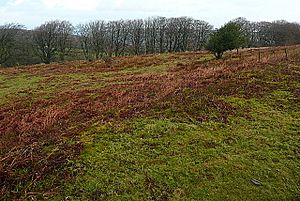Sweetworthy facts for kids
Quick facts for kids Sweetworthy |
|
|---|---|

Enclosure at Sweetworthy
|
|
| Location | Porlock, Somerset, England |
| Area | 0.25 hectares (0.62 acres) |
| Built | Iron Age |
| Reference no. | 35980 |
| Lua error in Module:Location_map at line 420: attempt to index field 'wikibase' (a nil value). | |
Sweetworthy is an amazing historical site in Somerset, England. It's located near Luccombe, about 4 kilometers (2.5 miles) south of Porlock. This special place holds the remains of two ancient Iron Age hill forts or enclosures. These old structures sit on the side of Dunkery Hill.
One of the hill forts at Sweetworthy has a single protective wall, called a rampart. It also has a ditch outside it. This area covers about 0.25 hectares (0.62 acres). You can still see the rampart today. The ditch on the east side is even used as a pathway! There was also a defended settlement built above the main site.
Sweetworthy is also home to a deserted medieval village. This means people used to live there a long time ago, but then everyone left. Both the hill forts and the medieval village are protected as Ancient monuments. However, the site is on the Heritage at Risk Register. This is because plants growing there could damage the old remains.
What are Hill Forts?
Hill forts are large, protected settlements. They were built on hills during the Late Bronze Age and Early Iron Age. This was roughly around 1000 BC. People built them by digging ditches and piling up earth to make strong walls. These walls are called ramparts.
Why Were Hill Forts Built?
Experts have thought a lot about why hill forts were built. Some believe they were military sites. Maybe they were built to defend against invaders from other parts of Europe. Others think they were built because of fighting between groups of people in Britain. This fighting might have happened as the population grew. More people meant more pressure on farming and resources.
Many experts now think that changes in society played a big role. When people started using iron more, it changed trade routes. Iron ore was found in different places than the metals used for bronze. This meant that old leaders might have lost their power. New groups of people became important.
Archaeologist Barry Cunliffe believes that a growing population was still a factor. He said that hill forts offered places for communities to defend themselves. This was important when tensions led to open fighting. But he also thought they weren't just built because there was a constant war. They were useful strongholds when needed. Some were attacked, but defense wasn't their only purpose.

